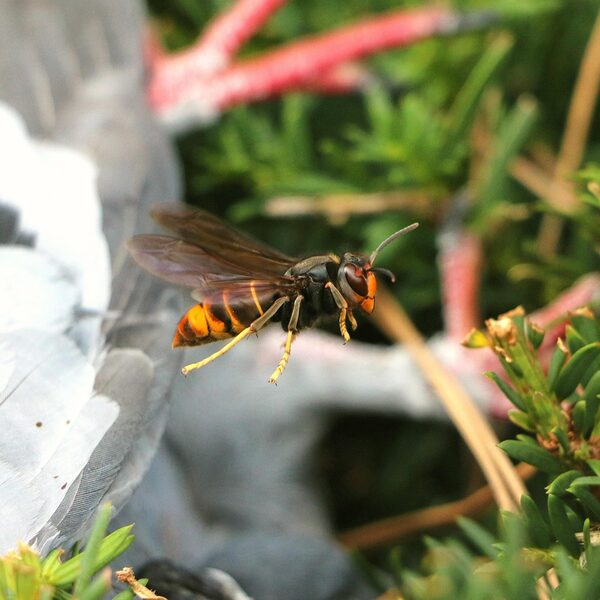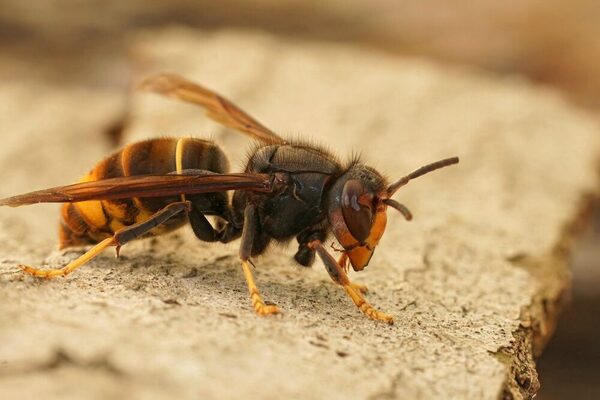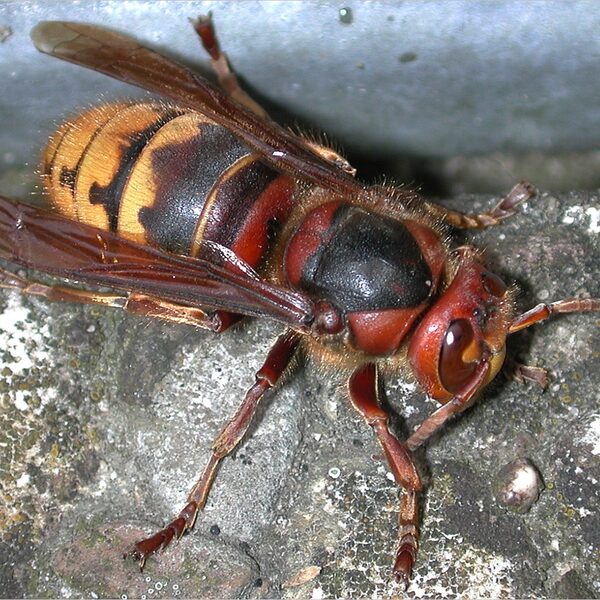Asian hornets
The Asian hornet is an alien species. It is currently spreading rapidly and poses a threat to native wild and honey bees. The Asian hornet is considered an invasive species.
Animals on a "world tour" - how did the Asian hornet get to Wiesbaden?
The Asian hornet of the subspecies Vespa velutina nigrithorax was probably accidentally introduced to Europe through the movement of goods from China.
The first nest was found in France as early as 2004. Since then, the species has also spread to Germany. Asian hornets had already been spotted in all federal states before 2020.
The first nest in Wiesbaden was reported in Biebrich in 2023. In the following year, reports were received from Klarenthal, Naurod, Südost, Delkenheim and Kostheim. There were probably also nests in other districts.
The climate change that has already occurred creates favorable conditions for Asian hornets. It is safe to assume that the colonization density of this wasp species in Germany will increase significantly in the future. The distribution area in Europe will also continue to expand. Various studies have estimated a dispersal tendency in Europe of between 78 and 100 km per year.
The expectation that the species can be completely eradicated must be regarded as unrealistic. However, monitoring and containment measures can help to reduce the negative impact on honey bees and native wild insects.
Why is this a "problem type"?
The larvae of the Asian hornet feed mainly on other insects. This is worrying for beekeepers, as the workers of the Asian hornet prefer to ambush their prey at beehives. This can lead to significant losses in bee colonies. Stress reactions also lead to the bees no longer leaving their hive (so-called feeding paralysis).
The Asian hornet also poses a threat to the populations of native wild bees, which are already dwindling.
Individual Asian hornets are no more dangerous to humans than the native species. Individual stings do not cause any lasting damage to the human organism in people who are not allergic. However, the stings are extremely painful over a long period of time.
Problems can arise if the Asian hornet's nests are approached too closely. Especially in the large summer nests, there are significantly more animals than in the nests of the native hornet. At the peak of nest development, there can be several thousand animals in one nest. In addition, the occupants are very willing to defend themselves. If you get too close to a nest, it can lead to unpleasant conflicts with the many animals.
Distinction between Asian hornet and native hornet
The effects on (wild) bees and other insects described above are not caused by our native hornets. One or two bees are also on the menu of the native hornet. However, their hunting strategies are in no way comparable to those of the Asian hornet. Native hornets are also much more peaceful when approaching a nest. With a little caution, the animals can be observed there without any unpleasant collisions.
External features
Individuals of the European and Asian hornet are easy to distinguish as they are similar in size and build but different in color:
| Asian hornet | European hornet | |
| Head/chest | black | reddish brown |
| Abdomen | predominantly black with a narrow yellow stripe at the front and yellow/orange bands at the end of the abdomen | reddish-brown near the breast, then yellow/brownish with dots and black stripes |
| Legs | black near the body - yellow at the end | Legs reddish brown throughout |
Nest building
There are also clear differences between the nests of the two species.
| Asian hornet | European hornet | |
| Nest entrance | sideways | bottom as if cut off |
| Location |
Primary nests at the beginning of the year vary in location, often found at low altitudes. Secondary nests predominantly free at greater heights (e.g. treetops) |
Nest foundation always in cavities or dark spaces (occasionally extending outwards if space is limited) |
Especially in spring, in the initial phase of nest establishment (usually from April, but possible much earlier in mild weather), so-called primary nests are often found in areas close to the ground. During the course of the year, secondary nests are built by the workers, which grow into large structures. Secondary nests are usually found at greater heights. They are often found in treetops, where they are protected from view by the leaves, but still catch the eye due to their sometimes enormous size.
What is being done to combat the invasive species and how can you get actively involved?
The Asian hornet is covered by the EU regulation on invasive alien species, so its presence and spread in Europe is closely monitored. With the declaration as an invasive alien species in 2016, "Member States [of the EU] are obliged to take measures against the unintentional introduction and for the early detection and rapid eradication of these species and to combat species that are already widespread on their territory."
This means that there is also a basic obligation to report. If you find a nest or individual animals that could be Asian hornets, please contact the Hesse reporting portal.
The state of Hesse is responsible for the management of invasive species. The Hessian State Agency for Nature Conservation, Environment and Geology (HLNUG) monitors the spread of the species and initiates control measures if the presence of Asian hornets is confirmed.
You are also welcome to inform the Bee, Wasp and Hornet Advisory Service of the Environmental Agency about your findings.
Further information
- Information on invasive species in Hesse - Hessian Ministry of Agriculture and Environment, Viticulture, Forestry, Hunting and Homeland (opens in a new tab)
- Hessian State Agency for Nature Conservation, Environment and Geology on Asian hornets with link to the Hesse reporting portal (opens in a new tab)
- European hornets
Contact us
Bee, wasp and hornet protection - advice
Address
65189 Wiesbaden
Postal address
65029 Wiesbaden
Arrival
Notes on public transport
Bus stop Statistisches Bundesamt; bus lines 16, 22, 27, 28, 37, 45, X26, x72, 262
Telephone
- +49 611 313733
- +49 611 313957
Information on accessibility
- Barrier-free access is available
- The WC is barrier-free


